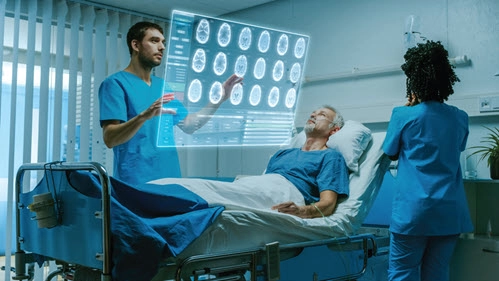Health Information Compliance Alert
Harness Augmented Reality to Enhance Patient Care
Tip: AR can be a critical tool in pediatric settings.
As technology in healthcare continues to evolve, there’s no telling what problems can be solved. Consider this deep dive on how augmented reality (AR) might help boost your patients’ health outcomes in 2022.
AR has the potential to transform healthcare. Whether used as a tool for technicians to keep critical medical machines operational, a tool for physicians to test complicated surgical procedures, or a way to inspire pediatric patients to improve their mobility, the possibilities are endless
Definition: AR is an interactive experience where technology creates a computer-generated image and superimposes it on a view of your real world. Typically, you’ll use AR on your smartphone or tablet, which allows you to move around and explore your surroundings while enjoying the alternative view. You’ll find numerous apps that create a fun, interactive AR experience on your mobile device.
Read on for the AR scoop.

Overcome Hospital Fears Through Augmented Reality
“The hospital can be an unfamiliar and scary place even for the bravest kids. When patients are anxious, they are unable to process and respond in a healthy way,” says Christina York, CEO and Founder of SpellBound (Source: www.youtube.com/watch?v=wzUwgoxr-Ys.) “AR has been shown to be effective at transforming patient perceptions of their environment. And because it’s powerful in changing perceptions, it has been used effectively in exposure and phobia therapy,” York says.
Example: The gamification of movement has gained popularity through stylish fitness trackers and gaming consoles, but a few years ago, Pokémon GO took the world by storm. By combining movement gamification and augmented reality, the game lets you view the characters in your backyard, outside of the post office, and in the park while encouraging you to move to those locations. This concept was revolutionary and inspired numerous other games and apps that let you play levels with your surroundings as the backdrop through the lens on your smartphone or tablet.
While the gameplay is simple, the benefits are exceptional. Players, especially children, move for fun and improve their health without really realizing it. But how could this idea benefit children who have limited mobility? AR has the capability to motivate pediatric patients to overcome their mobility challenges.
Spellbound designed an interactive and engaging game that uses augmented reality to tell a story that appeals to young players while also promoting mobility. Players scan wall decals with their mobile device’s camera, and then they’re able to unlock different characters in the game. Plus, the decals can be repositioned throughout the patient’s room, bathroom, in the hallways, and other safe spaces of the facility to encourage movement.
York says, “[AR helps by] allowing and encouraging kids to self-direct and self-motivate while care teams are able to receive critical baseline mobility data.”
Take Advantage of AR to Improve Surgeries
AR can improve patient outcomes in other ways.
With AR, surgeons can view the internal structures of a patient’s body before even picking up a scalpel. Whether they’re practicing complicated procedures or are performing a delicate surgery that could greatly improve the quality of life for the patient, surgeons in many specialties can benefit greatly from the use of AR in and out of the OR.
One case at Johns Hopkins University School of Medicine involved a patient who was experiencing debilitating back pain, and they were slated for spinal surgery. The spine neurosurgeon used an augmented reality headset to view the body’s surface anatomy and the internal structures of the bone, so he could carefully place screws into the patient’s spine.
Major benefit: “I think [AR is] going to be more effective and accurate for patient care. And it’s going to make what we do better with better outcomes, more efficiency, [and] better accuracy of placement of spinal instrumentation,” says Timothy Witham, MD, Director of the Johns Hopkins Neurosurgery Spinal Fusion Laboratory and Professor of Neurosurgery at the Johns Hopkins University School of Medicine in Baltimore, Maryland (Source: www.hopkinsmedicine.org/news/articles/johns-hopkins-performs-its-first-augmented-reality-surgeries-in-patients).

Use AR to Maintain Medical Machines
Finally, you may see AR integrated into machine maintenance.
Inpatient and outpatient facilities around the country are equipped with complex and expensive machines that are critical in imaging inside the patient’s body and maintaining stable conditions. Whether a facility has ventilators, mammography, ultrasounds, computed tomography (CT), or magnetic resonance (MR) machines, keeping the equipment operational is essential to diagnosing diseases, catching neoplasms, or caring for critical patients.
Since the start of the COVID-19 pandemic, GE Healthcare has ramped up its use of AR to train field engineers and technicians to maintain and repair valuable healthcare equipment. Instead of pouring over CAD diagrams or paper manuals, specialists can bring up a model on their phone or tablet in augmented reality and disassemble the physical machine with a 3D version on their screen. By guiding the engineers through the process of disassembling these incredibly technical pieces of equipment, the augmented reality provides a clear view of the machines that can be moved as the technician moves around the room. Read about GE Healthcare’s research at www.ptc.com/en/resources/augmented-reality/webcast/ar-training-builds-resilient-workforce.
When the pandemic began to grab a foothold in other countries, such as Italy, the company used AR to assist engineers and medical staff preparing for the arrival of ventilators. The AR program created an image of the ventilator on the staff’s displays, so they could make sure there was adequate space in the facility to accommodate the footprint of each ventilator. Plus, when the ventilators arrived, the staff used AR to smoothly move through the installation process.
Bottom line: AR can improve many facets in the healthcare field and the lives of patients.
Health Information Compliance Alert
- HIPAA:
OCR Bolsters Public Safety With Guidance on Extreme Risk Protection Orders
Update offers clarity on PHI disclosures in crisis situations. Since the pandemic began, the feds [...] - Spotlight On Technology:
Harness Augmented Reality to Enhance Patient Care
Tip: AR can be a critical tool in pediatric settings. As technology in healthcare continues [...] - Revenue Booster:
Utilize Internal Audits to Nix 2022 Billing Woes
Tip: Use monthly data reports to nip problems in the bud. With the Omicron variant [...] - Reader Questions:
Consider This Advice Before Giving Free Samples to Patients
Question: Our practice physicians have frequently supplied free samples to our patients. The samples are usually [...] - Reader Questions:
Understand HIPAA Protections for Decedents
Question: As a skilled nursing facility, what are our responsibilities for protecting or distributing private [...] - Reader Questions:
Know the Rules on Sharing Restricted PHI
Question: Does our practice have to honor a patient’s request to limit or restrict disclosures of [...] - Industry Notes:
HHS Boosts HIT With COVID-19-Inspired Program
Since the pandemic began, many systemic healthcare issues have been in the news. Among the [...] - Industry Notes:
OIG Offers Insight Into Telehealth Trends During COVID
Telehealth visits performed during the public health emergency (PHE) continue to be on the HHS [...]

